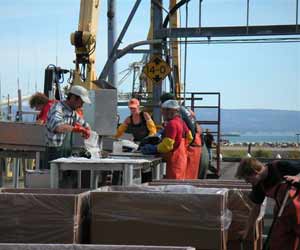Alaska Summer Seafood Processing Jobs
During the peak of a productive salmon season, first-time workers put in 12-18-hour days, seven days a week.
They are paid base wages ranging from Alaska minimum wage ($10.85/hour as of January 1, 2023) to $18.00 per hour with returnees earning even more. Substantially boosting one’s earnings is overtime pay, calculated at one and one-half times the normal rate ($16.27 to $27). Performance bonuses and extras (30¢ to 50¢ per hour worked for the freezer crew), are also commonplace.

Raises are typically given after an employee has worked 300 hours (about a month) and the hours often carry over from year to year.
In the words of a seasonal worker: “I came up here to make money and expecting to hate it, but I managed to have a blast and went home with enough money to buy a car.”
What are working conditions like? Many specific jobs require the employee to stand in one place for long periods of time while performing repetitious tasks. However, there can be great variance between one type of job and another, and the foreman may frequently assign individual employees to different tasks on a weekly or daily basis. You could be working inside or outside, in the freezer or warehouse.
One worker pointed out that the job really isn’t as bad as it sounds: “Though it was real repetitive work, sliming really wasn’t that bad. They played good tunes and fed us really well. The management was much cooler than I expected.”
Variety exists, but newcomers or “green” workers should be aware that they will probably begin as slimers or egg house employees. Hard workers may spend only a short time sliming (a few days to a week) before moving on to a better job and added responsibility.
Although working in a fresh frozen plant or cannery can mean long hours and cold, wet work, it’s not all bleak! Most companies give employees paid 10-minute breaks every two hours and longer meal periods every four hours. If you are working at a plant that has a cafeteria and company-provided food, take comfort in the fact that you can eat very well at a low cost (or at no cost at all!). Many operations even provide donuts, fresh fruit, and coffee during shorter break periods. So, if you regularly put in 15-hour days, you are assured of several coffee and meal breaks. Additionally, during your breaks, you’ll have the opportunity to meet people, talk to those you have been working with on the slime line, and make friends. As one worker said: “They expected us to work long, hard hours; however, they treated us fairly. They did everything possible to make the bunkhouse pleasant. The meals and break snacks were delicious.”
In order to give you a better idea of the kind of work available, we have put together a list of jobs commonly available at canneries and fresh frozen plants.


 Teach English in Asia
Teach English in Asia  Cruise Ship Jobs
Cruise Ship Jobs  Alaska Fishing Industry Jobs
Alaska Fishing Industry Jobs  Sharing Economy / Gig Economy
Sharing Economy / Gig Economy